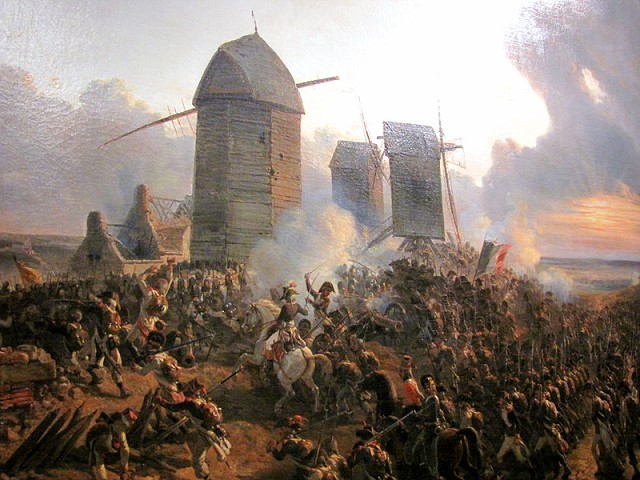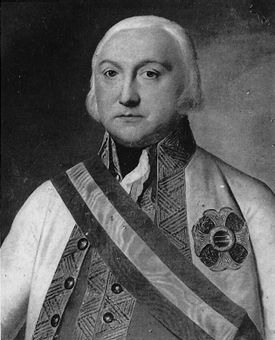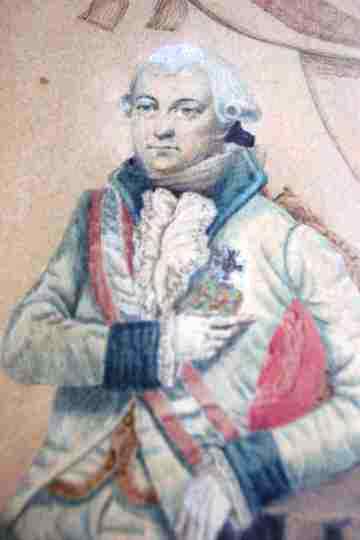|
Battle Of Beaumont (1794)
The Battle of Beaumont-en-Cambrésis 26 April 1794 (sometimes referred to as the Battle of Coteau, or in France the Battle of Troisvilles) was an action forming part of a multi-pronged attempt to relieve the besieged fortress of Landrecies, during the Flanders Campaign of the French Revolutionary War. The British and Austrians under the Duke of York defeated a French advance northwards from Cambrai commanded by René Chapuis. Background In April 1794 the Dutch States Army under William, Hereditary Prince of Orange lay besieging the French-held fortress of Landrecies, covered by a field army that stretched in a semi-circle from Maroilles in the east through Catillon-sur-Sambre in the south to Le Cateau-Cambrésis on the west. The right wing at Le Cateau was under the command of the Prince Frederick, Duke of York. The French Army of the North commanded by Jean-Charles Pichegru had been greatly bolstered during the winter by new recruits thanks to the Levee en Masse instig ... [...More Info...] [...Related Items...] OR: [Wikipedia] [Google] [Baidu] |
War Of The First Coalition
The War of the First Coalition (french: Guerre de la Première Coalition) was a set of wars that several European powers fought between 1792 and 1797 initially against the constitutional Kingdom of France and then the French Republic that succeeded it. They were only loosely allied and fought without much apparent coordination or agreement; each power had its eye on a different part of France it wanted to appropriate after a French defeat, which never occurred. Noah Shusterman – ''De Franse Revolutie (The French Revolution).'' Veen Media, Amsterdam, 2015. (Translation of: ''The French Revolution. Faith, Desire, and Politics.'' Routledge, London/New York, 2014.) Chapter 7 (p. 271–312) : The federalist revolts, the Vendée and the beginning of the Terror (summer–fall 1793). Relations between the French revolutionaries and neighbouring monarchies had deteriorated following the Declaration of Pillnitz in August 1791. Eight months later, following a vote of the revolutionar ... [...More Info...] [...Related Items...] OR: [Wikipedia] [Google] [Baidu] |
Army Of The North (France)
The Army of the North or Armée du Nord is a name given to several historical units of the French Army. The first was one of the French Revolutionary Armies that fought with distinction against the First Coalition from 1792 to 1795. Others existed during the Peninsular War, the Hundred Days and the Franco-Prussian War. Campaigns 1791 to 1797 At the creation of the Army of the North on 14 December 1791, the government of the Kingdom of France appointed Jean-Baptiste Donatien de Vimeur, Comte de Rochambeau, as its commander. Rochambeau was replaced in May 1792, and he retired from service. The suspicious government of the First French Republic later charged him with treason and he barely escaped execution. In 1792-1794, the guillotine awaited military commanders who either failed, belonged to the nobility, or displayed insufficient revolutionary zeal. In the Army of the North these unfortunates included Nicolas Luckner, Adam Custine, and Jean Houchard. Under Charles François ... [...More Info...] [...Related Items...] OR: [Wikipedia] [Google] [Baidu] |
Oisy, Nord
Oisy () is a commune in the Nord department in northern France. Heraldry See also *Communes of the Nord department The following is a list of the 648 communes of the Nord department of the French Republic. The communes cooperate in the following intercommunalities (as of 2020):Communes of Nord (French department) {{Nord-geo-stub ... [...More Info...] [...Related Items...] OR: [Wikipedia] [Google] [Baidu] |
Count Heinrich Von Bellegarde
Count Heinrich von Bellegarde, Viceroy of Lombardy-Venetia (german: Heinrich Joseph Johannes, Graf von Bellegarde or sometimes ''Heinrich von Bellegarde''; 29 August 1756 – 22 July 1845), of a noble Savoyard family, was born in Saxony, joined the Saxon army and later entered Habsburg military service, where he became a general officer serving in the Habsburg border wars, the French Revolutionary Wars and the Napoleonic Wars. He became a ''Generalfeldmarschall'' and statesman. Early career Born in Dresden in the Electorate of Saxony on 29 August 1756, his family stemmed from an old line of Savoairds. His father was the Saxon General Johann Franz von Bellegarde (named count in 1741) and his mother was ''Frau Reichsgräfin'' Maria Antonia von Hartig. Bellegarde first served in the Saxon army, receiving a commission as a ''Fähnrich'' (ensign) in the Infantry Regiment Bork; later as a lieutenant in the Queen's regiment. Transferring his services to Austria in 1771, Bellegarde and ... [...More Info...] [...Related Items...] OR: [Wikipedia] [Google] [Baidu] |
Archduke Charles, Duke Of Teschen
Archduke Charles Louis John Joseph Laurentius of Austria, Duke of Teschen (german: link=no, Erzherzog Karl Ludwig Johann Josef Lorenz von Österreich, Herzog von Teschen; 5 September 177130 April 1847) was an Austrian field-marshal, the third son of Emperor Leopold II and his wife, Maria Luisa of Spain. He was also the younger brother of Francis II, Holy Roman Emperor. Despite being epileptic, Charles achieved respect both as a commander and as a reformer of the Austrian army. He was considered one of Napoleon's more formidable opponents and one of the greatest generals of the French Revolutionary Wars. He began his career fighting the revolutionary armies of France. Early in the wars of the First Coalition, he saw victory at Neerwinden in 1793, before being defeated at Wattignies 1793 and Fleurus 1794. In 1796, as chief of all Austrian forces on the Rhine, Charles defeated Jean-Baptiste Jourdan at Amberg, Würzburg and Limburg, and then won victories at Wetzlar, Emmendingen a ... [...More Info...] [...Related Items...] OR: [Wikipedia] [Google] [Baidu] |
Franz Joseph, Count Kinsky
Franz Joseph, Count Kinsky of Wchinitz and Tettau (6 December 1739 – 9 June 1805) was a Habsburg Austrian general in the War of the Bavarian Succession and the French Revolutionary Wars. A nobleman from the House of Kinsky, he began his military service in 1759 and within ten years he commanded an infantry regiment. Ahead of his time, he began a school in his regiment to train officer cadets. As a general officer he led troops in a successful action against Prussia in 1778. A year later he was appointed Inhaber of an infantry regiment and Director of the Theresian Military Academy in Wiener Neustadt; he held both posts during the remainder of his life. In the Flanders Campaign in 1794, he commanded an infantry division against the French. He led an attack column at Tourcoing where he failed to support Prince Frederick, Duke of York and Albany. He was promoted to Feldzeugmeister in September 1794. He held no more active commands and died at Vienna in 1805. Early career Franz Jos ... [...More Info...] [...Related Items...] OR: [Wikipedia] [Google] [Baidu] |
József Alvinczi
Freiherr Joseph Alvinczi von Borberek a.k.a. Baron József Alvinczi de Borberek (german: Joseph Alvinczy, Freiherr von Berberek; 1 February 1735 – 25 September 1810) was a soldier in the Habsburg Army and a field marshal of the Austrian Empire. Early career An ethnic Magyar, he was born in Transylvania in a place called Alvinc (German: ''Alwintz''), and spent his boyhood in the household of ''Graf'' Franz Gyulai before joining his regiment as a '' Fähnrich'' aged 14. By 1753 he had risen to ''Hauptmann''. During the Seven Years' War, Alvinczy distinguished himself leading a grenadier company in the battles of Torgau and Teplitz, where his courageous leadership won him a promotion to second major. At the end of the war he worked extensively on the implementation of Franz Moritz von Lacy's new regulations throughout the army. War of Succession, Turkish War, and the Netherlands campaign Promoted to ''Oberst'' commanding the 19th Infantry Regiment 19 in 1774, he led hi ... [...More Info...] [...Related Items...] OR: [Wikipedia] [Google] [Baidu] |
Prisches
Prisches () is a commune in the Nord department in northern France. History Catharina Trico, born at Prisches (then part of the Spanish Netherlands) emigrated in the early 17th Century to Amsterdam. On January 13, 1624, she - 18 years old at the time - married a fellow Walloon immigrant, Joris Raparlie from Valenciennes, the record of their marriage surviving in Amsterdam archives. The two of them soon afterwards boarded a Dutch ship bound for North America and were among the founders and original inhabitants of New Amsterdam - which eventually became the present New York City. Further surviving documents indicate that Catharina and Joris had eleven children, that he died in 1662 but that she was still alive in 1680 - when an English missionary encountered her on Long Island as an old matriarch with 145 descendants. Genealogists estimate that more than a million people now living, in the US and elsewhere, can trace their descent to her.The documents telling the story of Cathar ... [...More Info...] [...Related Items...] OR: [Wikipedia] [Google] [Baidu] |
Jacques Fromentin
Jacques Pierre Fromentin (2 August 1754 – 19 October 1830) led a French division during the Flanders Campaign of 1793–1794. Having served in the French Royal Army for ten years, he was appointed lieutenant colonel of a volunteer battalion in 1791. The mass emigration of aristocratic generals, and suspicion of those who stayed, left the First French Republic desperate to create new general officers, preferably from non-nobles. After leading his battalion at Hondschoote, Fromentin was very rapidly promoted to general of division in September 1793 and led a division at Wattignies the following month. In 1794, he led a combat division at Le Cateau, Beaumont, Grandreng, Erquelinnes and Gosselies Gosselies ( wa, Gochliye) is a town of Wallonia and a district of the municipality of Charleroi, located in the province of Hainaut, Belgium. Located in the north of Charleroi, it was a city and a municipality of its own before the merger of the .... After the battle of Gosselies, ... [...More Info...] [...Related Items...] OR: [Wikipedia] [Google] [Baidu] |
Guise
Guise (; nl, Wieze) is a commune in the Aisne department in Hauts-de-France in northern France. The city was the birthplace of the noble family of Guise, Dukes of Guise, who later became Princes of Joinville. Population Sights The remains of the medieval castle of Guise, the seat of the Dukes of Guise, is within the commune. Economy Guise is the agricultural centre of the northern area of Aisne. Miscellaneous Guise was the birthplace of Camille Desmoulins (1760–1794), a journalist and politician who played an important part in the French Revolution, and that of Jeanne Macherez who was a heroine during the World War I. Over a period of 20 years, beginning about 1856, Jean-Baptiste Godin built the (the Social Palace), an industrial and communal residential complex that was a separate community within Guise. It expressed many of his ideas about developing social sympathy through improved housing and services for workers and their families, influenced by the ideas of th ... [...More Info...] [...Related Items...] OR: [Wikipedia] [Google] [Baidu] |
Jacques Ferrand (general)
Jacques Ferrand was a French physician born around 1575 in Agen, France. He is famous for his treatise on melancholia, ''Traicte de l'essence et guerison de l'amour ou de la melancholie erotique'' (1610), an early psychological work on melancholia. It was for this work he was put on trial for by the Inquisition. Donald A. Beecher: "Erotic Love and the Inquisition: Jacques Ferrand and the Tribunal of Toulouse, 1620". ''The Sixteenth Century Journal'', Vol. 20, No. 1 (Spring, 1989), pp. 41-53 . The treatise on erotic melancholia may have been read by the French writer, Eugène Sue, whose character "Jacques Ferrand" Mysteries of Paris" actually dies from an unrequited passion. Sue's father had been a distinguished doctor, and Sue himself was engaged in the medical profession when he was a young man. In 1623, Ferrand wrote a book about the uses of bloodletting to cure "heartbreak" and "heartsickness" (figurative). He posited that the person being cured of heartbreak should be bled almo ... [...More Info...] [...Related Items...] OR: [Wikipedia] [Google] [Baidu] |
Franz Wenzel, Graf Von Kaunitz-Rietberg
Franz Wenzel, Graf von Kaunitz-Rietberg (2 July 1742 in Vienna – 19 December 1825 in Vienna) was an Austrian general who saw service in the Seven Years' War and Wars of the French Revolution. Life Kaunitz was the third son of the statesman Wenzel Anton von Kaunitz-Rietberg and his wife, Mary Ernestine (''née'' Countess Starhemberg). He remained unmarried. ;Military career Kaunitz was given a military education and volunteered to join the Austrian army at the beginning of the Seven Years' War as an ensign in the Trautmannsdorf Cuirassiers. He transferred to the Daun Infantry Regiment in 1759, and under Field Marshal Leopold Joseph von Daun rose to the position of Wing Adjutant, distinguishing himself at the Battle of Torgau, where he was severely wounded. After the peace of Hubertusburg in 1763, he was promoted to Colonel of the Baden Infantry Regiment (IR; later IR.23), and then in 1766 of the Emperor Joseph II Infantry Regiment (later IR.1). In 1773, he was promoted to Gen ... [...More Info...] [...Related Items...] OR: [Wikipedia] [Google] [Baidu] |





